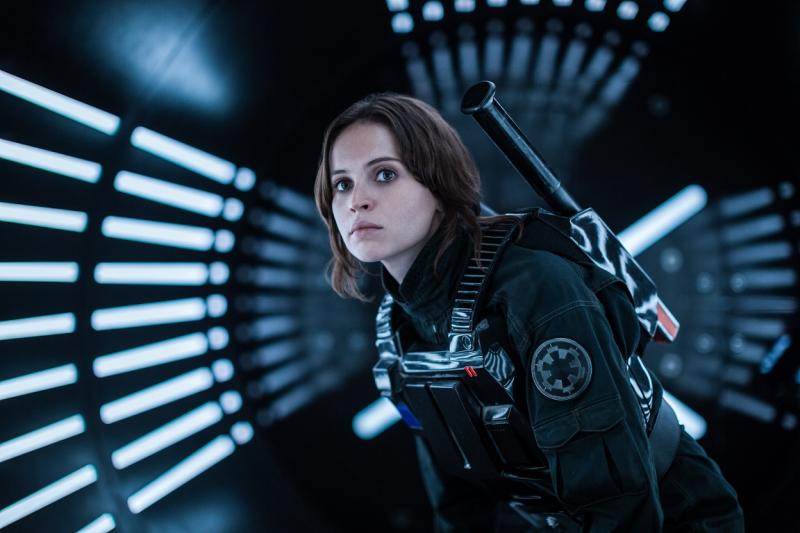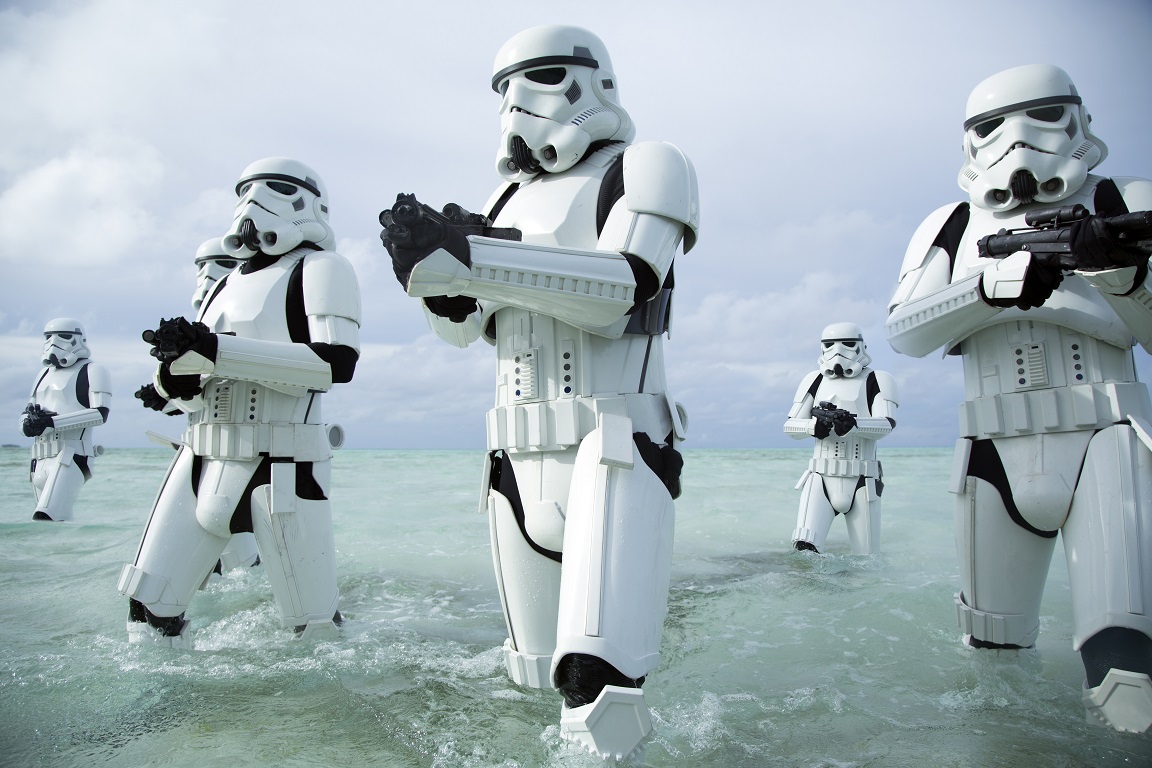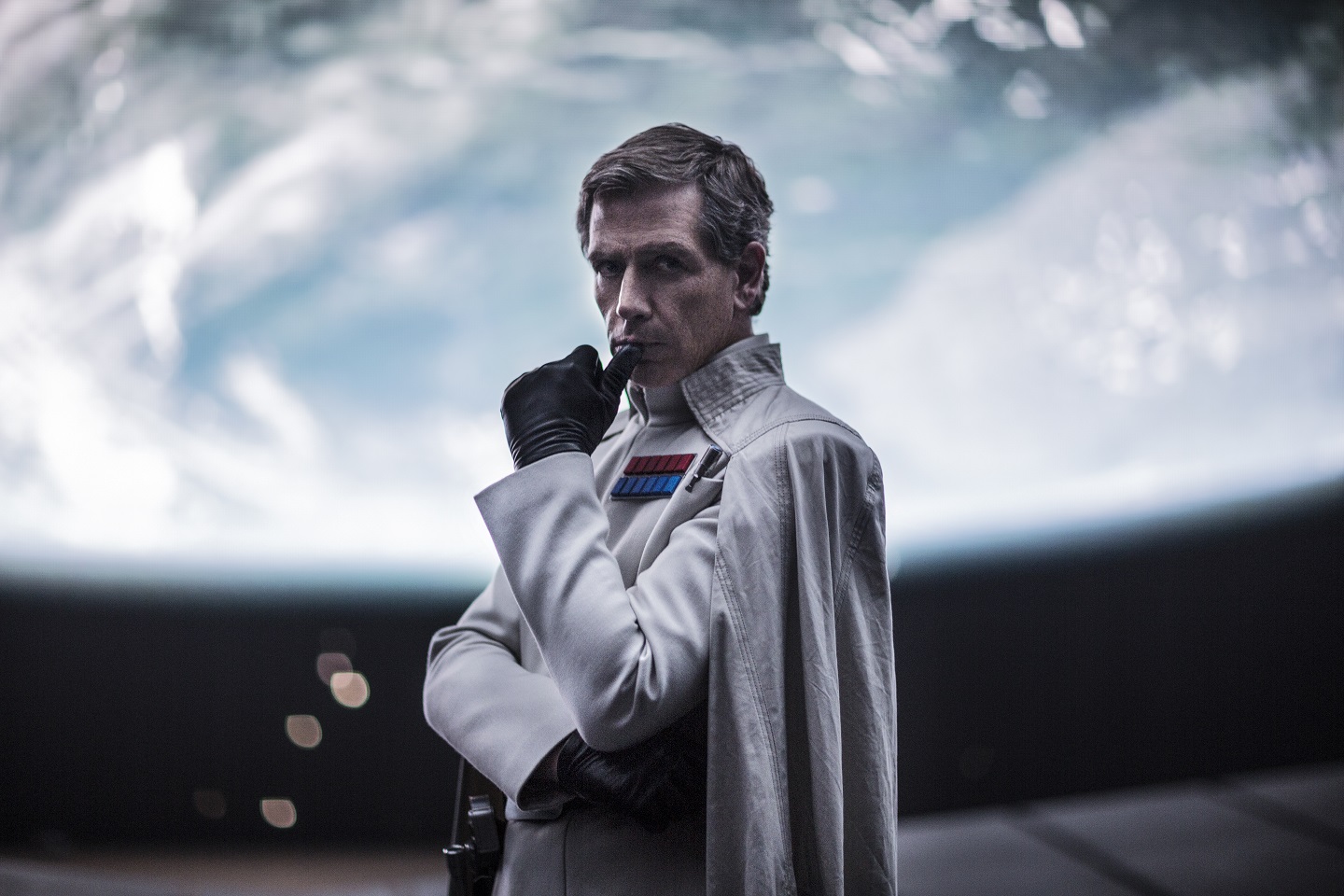Rogue One: A Star Wars Story | reviews, news & interviews
Rogue One: A Star Wars Story
Rogue One: A Star Wars Story
The Star Wars franchise detours down a side-turning to a raw new direction

Whether you use its optional subtitle A Star Wars Story or not, Rogue One arrives with a diminutive air.
Even this prologue has a prologue, recalling Tarantino’s Inglorious Basterds opening as Imperial Director Krennic visits the windblown farm where his former, brilliant scientist employee Galen Erso (Mads Mikkelsen) has retreated from his noxious duties, to be with his wife and young daughter, Jyn. Galen’s child watches as he’s cruelly snatched back into decades of work on the Death Star, and the sense of flesh and bone in this chilly scene, building on the newly explicit Nazi-style oppression seen in The Force Awakens, is maintained for much of Rogue One.
 Chris Weitz and Tony Gilroy’s sharp-witted screenplay also brings the Rebel Alliance nearer to such an organisation’s reality, admitting the saboteurs, assassins, bomb-makers and killers of innocents with which the French Resistance functioned and, in the breakaway, black-cloaked wing led by Saw Gerrera (Forest Whitaker), their own mujahideen. The adult Jyn (Felicity Jones) is kidnapped by one of those ruthless Rebels, Cassian Andor (Diego Luna), so she can be exploited to get close to dad Galen, snuffing out him and his work on the rumoured, nightmarish Death Star. As in The Force Awakens, there is an Imperial pilot defector (played with quietly damaged, gradual heroism by Riz Ahmed). As with the dirty white armour of Stormtroopers on an occupied planet here, his moral grey is more matter of fact than the Force’s former, conflicted white and black knights. With Donnie Yen’s blind Jedi adherent Chirrut and Jiang Wen as his assassin companion, this film’s ragtag, polyglot company also stand in happy contrast to the white Californian-looking humans of '77’s Alliance.
Chris Weitz and Tony Gilroy’s sharp-witted screenplay also brings the Rebel Alliance nearer to such an organisation’s reality, admitting the saboteurs, assassins, bomb-makers and killers of innocents with which the French Resistance functioned and, in the breakaway, black-cloaked wing led by Saw Gerrera (Forest Whitaker), their own mujahideen. The adult Jyn (Felicity Jones) is kidnapped by one of those ruthless Rebels, Cassian Andor (Diego Luna), so she can be exploited to get close to dad Galen, snuffing out him and his work on the rumoured, nightmarish Death Star. As in The Force Awakens, there is an Imperial pilot defector (played with quietly damaged, gradual heroism by Riz Ahmed). As with the dirty white armour of Stormtroopers on an occupied planet here, his moral grey is more matter of fact than the Force’s former, conflicted white and black knights. With Donnie Yen’s blind Jedi adherent Chirrut and Jiang Wen as his assassin companion, this film’s ragtag, polyglot company also stand in happy contrast to the white Californian-looking humans of '77’s Alliance.
Dirty realism only goes so far in Star Wars, of course. The final reel includes a series of epic, sometimes overlong space and land battles, from the rain-lashed planet where the Death Star has been researched to the beaches and forests of the planet where its secrets are filed, with Star Destroyers lumbering and fighter pilots darting in their hundreds overhead.
 The film’s timeframe and advances in technology allow old favourites’ return, motion-capture presumably reanimating Peter Cushing’s Grand Moff Tarkin – here a merciless bureaucrat in a turf war with Krennic, with the Death Star as an instrument of office politics – and Carrie Fisher’s young Leia, alongside R2D2, C3PO and a Darth Vader whose two short scenes make him memorably Gothic, resting in a crepuscular castle, and slaughtering terrified, trapped Rebels like a rampaging Dracula. Ben Mendelsohn (above), the most reliably dangerous actor working, makes Krennic an earthier, striving, worried villain, rationalising oppression and seeing the beauty in an explosion killing millions. Luna gives this film’s Han Solo, Cassian, a nervous, appealing edge. Jones matches him where she can as an underwritten but effectively tough, farm-girl heroine. Cleverly extrapolating from and fixing faults in the original Star Wars, our own digital present makes the physical nature of the Death Star's crucial plans seem equally odd. But this is still, self-consciously, science-fiction from 1977.
The film’s timeframe and advances in technology allow old favourites’ return, motion-capture presumably reanimating Peter Cushing’s Grand Moff Tarkin – here a merciless bureaucrat in a turf war with Krennic, with the Death Star as an instrument of office politics – and Carrie Fisher’s young Leia, alongside R2D2, C3PO and a Darth Vader whose two short scenes make him memorably Gothic, resting in a crepuscular castle, and slaughtering terrified, trapped Rebels like a rampaging Dracula. Ben Mendelsohn (above), the most reliably dangerous actor working, makes Krennic an earthier, striving, worried villain, rationalising oppression and seeing the beauty in an explosion killing millions. Luna gives this film’s Han Solo, Cassian, a nervous, appealing edge. Jones matches him where she can as an underwritten but effectively tough, farm-girl heroine. Cleverly extrapolating from and fixing faults in the original Star Wars, our own digital present makes the physical nature of the Death Star's crucial plans seem equally odd. But this is still, self-consciously, science-fiction from 1977.
Probably the Proustian rush of John Williams’s theme (held back here) will become threadbare, as the Star Wars universe competes annually with Marvel’s for the box-office empire, until its simply effective DNA disintegrates. But not yet.
The future of Arts Journalism
You can stop theartsdesk.com closing!
We urgently need financing to survive. Our fundraising drive has thus far raised £49,000 but we need to reach £100,000 or we will be forced to close. Please contribute here: https://gofund.me/c3f6033d
And if you can forward this information to anyone who might assist, we’d be grateful.

Subscribe to theartsdesk.com
Thank you for continuing to read our work on theartsdesk.com. For unlimited access to every article in its entirety, including our archive of more than 15,000 pieces, we're asking for £5 per month or £40 per year. We feel it's a very good deal, and hope you do too.
To take a subscription now simply click here.
And if you're looking for that extra gift for a friend or family member, why not treat them to a theartsdesk.com gift subscription?
more Film
 Bugonia review - Yorgos Lanthimos on aliens, bees and conspiracy theories
Emma Stone and Jesse Plemons excel in a marvellously deranged black comedy
Bugonia review - Yorgos Lanthimos on aliens, bees and conspiracy theories
Emma Stone and Jesse Plemons excel in a marvellously deranged black comedy
 theartsdesk Q&A: director Kelly Reichardt on 'The Mastermind' and reliving the 1970s
The independent filmmaker discusses her intimate heist movie
theartsdesk Q&A: director Kelly Reichardt on 'The Mastermind' and reliving the 1970s
The independent filmmaker discusses her intimate heist movie
 Blu-ray: Wendy and Lucy
Down-and-out in rural Oregon: Kelly Reichardt's third feature packs a huge punch
Blu-ray: Wendy and Lucy
Down-and-out in rural Oregon: Kelly Reichardt's third feature packs a huge punch
 The Mastermind review - another slim but nourishing slice of Americana from Kelly Reichardt
Josh O'Connor is perfect casting as a cocky middle-class American adrift in the 1970s
The Mastermind review - another slim but nourishing slice of Americana from Kelly Reichardt
Josh O'Connor is perfect casting as a cocky middle-class American adrift in the 1970s
 Springsteen: Deliver Me From Nowhere review - the story of the Boss who isn't boss of his own head
A brooding trip on the Bruce Springsteen highway of hard knocks
Springsteen: Deliver Me From Nowhere review - the story of the Boss who isn't boss of his own head
A brooding trip on the Bruce Springsteen highway of hard knocks
 The Perfect Neighbor, Netflix review - Florida found-footage documentary is a harrowing watch
Sundance winner chronicles a death that should have been prevented
The Perfect Neighbor, Netflix review - Florida found-footage documentary is a harrowing watch
Sundance winner chronicles a death that should have been prevented
 Blu-ray: Le Quai des Brumes
Love twinkles in the gloom of Marcel Carné’s fogbound French poetic realist classic
Blu-ray: Le Quai des Brumes
Love twinkles in the gloom of Marcel Carné’s fogbound French poetic realist classic
 Frankenstein review - the Prometheus of the charnel house
Guillermo del Toro is fitfully inspired, but often lost in long-held ambitions
Frankenstein review - the Prometheus of the charnel house
Guillermo del Toro is fitfully inspired, but often lost in long-held ambitions
 London Film Festival 2025 - a Korean masterclass in black comedy and a Camus classic effectively realised
New films from Park Chan-wook, Gianfranco Rosi, François Ozon, Ildikó Enyedi and more
London Film Festival 2025 - a Korean masterclass in black comedy and a Camus classic effectively realised
New films from Park Chan-wook, Gianfranco Rosi, François Ozon, Ildikó Enyedi and more
 After the Hunt review - muddled #MeToo provocation
Julia Roberts excels despite misfiring drama
After the Hunt review - muddled #MeToo provocation
Julia Roberts excels despite misfiring drama
 London Film Festival 2025 - Bradley Cooper channels John Bishop, the Boss goes to Nebraska, and a French pandemic
... not to mention Kristen Stewart's directing debut and a punchy prison drama
London Film Festival 2025 - Bradley Cooper channels John Bishop, the Boss goes to Nebraska, and a French pandemic
... not to mention Kristen Stewart's directing debut and a punchy prison drama
 Ballad of a Small Player review - Colin Farrell's all in as a gambler down on his luck
Conclave director Edward Berger swaps the Vatican for Asia's sin city
Ballad of a Small Player review - Colin Farrell's all in as a gambler down on his luck
Conclave director Edward Berger swaps the Vatican for Asia's sin city

Add comment